Optics Dictionary
- A
- B
- C
- D
- E
- F
- G
- H
- I
- J
- K
- L
- M
- N
- O
- P
- Q
- R
- S
- T
- U
- V
- W
- X
- Y
- Z
-
Aberrations
Simple DifficultDefects found in optical instruments that cause images to appear deformed, with deteriorated sharpness or with color-dependent changes of the light used to produce them. -
Absorption
Simple DifficultThe process in which a body ‘takes in’ the energy of an electromagnetic wave, e.g. a light wave. This results in the lowering of the light’s intensity, while the internal energy of the body increases; in other words, when light falls on a body, the light that successfully passes through it will be dimmer than the original light and the energy of the absorbed light will be converted into heat energy. -
Apochromat
Simple DifficultA system of three lenses made from different types of glass (ED, fluorite), with different refractive indexes and dispersions, designed to correct chromatic aberration in three colors (e.g. red, blue, green) by concentrating them in the same plane (the image plane). It also eliminates spherical aberration. Apochromats are used for precision optical instruments (e.g. microscopes, telescopes). -
Astigmatism
Simple DifficultAn optical defect in lenses that produces blurred and distorted images. The light rays incident on the lens do not travel parallel to the optical axis. Depending on the direction of travel of the light rays in relation to the optical axis, the light converges at different points.
If the object is, say, a point, then the resulting image in this case is not a single point, but two ovals that are perpendicular to each other.
Astigmatisms are a very common defect in eyes. Both distant and close objects can appear blurry
-
Beamsplitter
Simple DifficultAn optical device that is used to split a beam of light into multiple beams -
Bell’s inequalities
Simple DifficultBell’s inequalities disproved the existence of the ‘hidden variables’ hypothesis in quantum mechanics.Theorem shows that no theory that satisfies the conditions imposed can reproduce the probabilistic predictions of quantum mechanics under all circumstances.
-
Candela
Simple DifficultThe unit of luminosity in a given direction. In other words, the Candela allows us to measure the amount of light falling from a source into a detector (such as the eye). The Candela is an SI fundamental unit and is denoted by \(cd \).The luminous intensity of a source emitting radiation of a wavelength \(\lambda ∼= 560nm \) and radiant intensity \( I = \frac{1}{683} \frac{W}{Sr} \) (Watts/Steradian). The radiation must be monochromatic. This measure of luminous intensity is carried out in a specific direction. The candela is classed as one of the SI units and is represented by the notation \(cd \). -
Cavity ring-down spectroscopy
Simple DifficultThe method of analyzing the properties of matter based on the absorption of light inside an optical cavity. -
Chromatic aberration
Simple DifficultA defect of a lens that causes light rays of different colors to focus at different distances from the lens.A feature of a lens or optical system. Each colour has a corresponding refractive index when the light passes through a given system. This causes the different colours to converge at different distances from the lens. One way to eliminate the chromatic aberration in the system is to use an achromatic doublet. There are two types of chromatic aberration: longitudinal and transverse. -
Chromatic aberration
Simple DifficultA phenomenon occurring in lenses and mirrors, in which light incident upon the optical device at different distances (in relation to the center of the optical device) focuses to different points., This is caused by different angles of refraction, depending on the distance from the axis of the lens or mirror. A phenomenon occurring in lenses and mirrors, in which light incident upon the optical device at different distances (in relation to the center of the optical device) focuses to different points., This is caused by different angles of refraction, depending on the distance from the axis of the lens or mirror.
A phenomenon occurring in lenses and mirrors, in which light incident upon the optical device at different distances (in relation to the center of the optical device) focuses to different points., This is caused by different angles of refraction, depending on the distance from the axis of the lens or mirror.
-
Coherence of light
Simple DifficultThe stability of light in terms of interference. This means that the light is made up of photons with the same phase, wavelength, and direction of propagation. In other words, light is coherent when its constituent waves have the same frequency and constant phase difference. Sources of coherent light are point sources and lasers. High coherence light is used in different types of interferometry, holography and some optical sensors. -
Coma
Simple DifficultA lens defect resulting from unequal magnifications in different areas of the lens. A coma is also referred to as comatic aberration.
-
Diffraction grating
Simple DifficultAn optical instrument used to find out the constituent colours of the light that passes through it. This is possible through the phenomena of diffraction and interference. A diffraction grating is built from equally spaced, identical arpetures (diffracting objects). The spacing between consecutive arpetures is known as the grating constant (d). -
Dispersion
Simple DifficultThe phenomenon in which the refractive index of a material depends on the wavelength of the light incident upon it. -
Distortion
Simple DifficultAn optical defect which causes the magnification of the resulting image to depend on the distance of the image from the center of the lens. There are two types of distortion: barrel and pincushion. In pincushion distortion, the magnification increases with the distance from the optical axis, and in barrel distortion it decreases.
-
Fermat’s principle
Simple DifficultAlso known as the principle of least time of light. Light travelling in any medium travels along the path from point A to point B that takes the shortest possible amount of time - this is not always the easiest and spatially shortest path. Using Fermat’s principle, one can derive the laws of refraction and reflection. -
Field curvature
Simple DifficultA defect in optical elements that causes the focal surface to be curved instead of planar. The resulting image will be sharp in the center but blurred at the edges the blur will be more noticeable further away from the centre of the optical axis. Field curvature is corrected with the appropriate selection of lenses. -
Focal Point
Simple DifficultThe distance (denoted by the letter \( f \)) between the focal point (the point at which the rays of light are focused to) and the mirror or lens that the light passed through. -
Focus
Simple DifficultThe point to which light rays are focused after passing through a lens or reflected from a mirror. This point lies on the optical axis of the lens or mirror and is denoted by the letter \( F \). The focus can also be the point at which the extension of the light rays meet (in the case of a diverging lens).The point (\( F \) ) at which:- two beams of light intersect with each other once they have passed through a converging optical system - this is called a real focal point. The source of emission of the two incident beams is placed at infinity, and thus the beams are parallel to each other before they pass through the system.
- the extensions of two beams of light intersect once they have passed through a diverging optical system called a virtual focal point.
-
Frequency comb
Simple DifficultA type of laser radiation, consisting of a series of impulses.
The laser spectrum consists of spectral lines parallel to each other, covering a wide range of frequencies.
Frequency combs are used to precisely measure electromagnetic radiation frequency. Optical atomic clocks make use of this function.
-
Hologram
Simple DifficultA three-dimensional photographic record created with laser light. A hologram is created by illuminating a holographic plate (with a high resolution) with two light beams coming from the same source. The light beam directed by a laser onto a glass plate is split in two. One part of the original beam passes through a diverging lens and then the diverging rays are reflected from a mirror. These rays are then reflected from the object and finally fall onto the holographic plate. The other part of the original beam is directed at a diverging lens, the diverging rays reflect from a mirror and finally fall onto the holographic plate.
-
Laser
Simple DifficultA laser emits radiation, e.g. visible light. The word ‘laser’ is actually an acronym: ‘Light Amplification by Stimulated Emission of Radiation’. Two of the most important properties of the photons of laser radiation are that they all have the same frequency and phase. Another important property is laser divergence – this allows for nearly all of the energy of the radiation to be directed in one direction. Lasers can be found in supermarkets – they are used to read barcodes on products. -
Laser pulses
Simple DifficultShort laser flashes. -
LEDs
Simple DifficultA light-emitting diode (or simply LED) device made from a semiconductor. Under the influence of an applied voltage it emits light.
Christmas lights and extra large telebeams at sport stadiums are often made up of LEDs. -
Lens
Simple DifficultOne of the simplest tools in optics. A lens can be defined as a trans- parent object (most commonly made of glass) bounded by two surfaces, with at least one of them being curved.
There are two main categories that lenses can be split into: ones that converge light (focus it to one spot called the focal point) and ones that diverge light (spread it out).
An example of a lens that everyone uses can be found in the eye. It is an example of a lens that converges light. -
Liquid crystals
Simple DifficultMaterials that can have the properties of both liquids and solids; the exact properties depend on the thermodynamic parameters. -
Lumen
Simple DifficultThe lumen is classed as an SI derived unit. It summarises the luminous intensity of light – that is, the amount of light radiated out from a point source. The light radiates out from the source identically in all directions. The more lumens a source has, the more light it emits.
-
Magnifying glass
Simple DifficultThe name given to a system of one or more converging lenses positioned closed together and fixed in place with a frame. Magnifying glasses are used to observe small objects that are in close proximity to each other. The objects one observes are, as the name suggests, magnified (that is, bigger than the real size of the object). -
Microscope
Simple DifficultAn instrument used to observe objects which cannot be observed with the naked eye. Microscopes are commonly used in biology to observe bacteria.
The most popular type of microscope is the optical microscope (or light microscope), in which light passes through an array of different lenses. The components of a basic optical microscope are as follows: an objective lens (the lens that produces the intermediate enlarged image of the object), an eyepiece (the lens that enlarges the image produced by the objective lens) and the body tube (that houses the former two components).
The diagram shows how light travels from the light source to the observer in a microscope.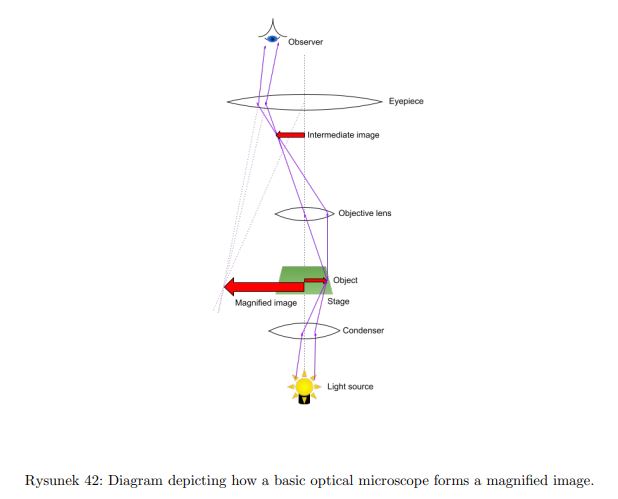
-
Monochromatic light
Simple DifficultLight that has only one specific frequency f. With regard to visible light, the term ‘monochromatic’ refers to light of a single colour. In practice, a source of purely monochromatic light does not exist, but continuous wavelength lasers close. -
Multimode fiber
Simple DifficultA type of optical fiber that can transmit many modes (spatial distributions of light). An optical fiber is a transparent fiberglass (usually silica) mixed with materials (e.g. fluorine) and is used to transmit light. The core diameter of multimode fibers is usually 50 µm or 62.5 µm, while the diameter of the cladding is 125 µm. Multimode fibers are used for communication over short distances only.
-
Neutral density filter
Simple DifficultA material that decreases the intensity of light over a large range of colors. -
Nonlinear optics
Simple DifficultA field within optics dealing with the analysis of the interactions of matter with high intensity light. Media becomes nonlinear when light of very high intensity (of order (105 − 108) V/m) is used.
-
Objective lens
Simple DifficultHe part of a microscope that creates a magnified image of the sample. -
Ocular lens
Simple DifficultThe part of a microscope whose purpose is to concentrate the image created by the objective lens onto the eye. -
Optical amplifier
Simple DifficultA device used for the direct amplification of optical signals, without the need for conversion to an electric signal. -
Optical Axis
Simple DifficultThe imaginary line perpendicular to the curved surfaces of a lens (although some lenses do have one straight surface) and passing straight through its geometric centre. An optical axis is also present in the case of mirrors, and also passes through the geometrical centre.The axis of symmetry of all reflecting (above) and re- fracting (below) planes in a given system.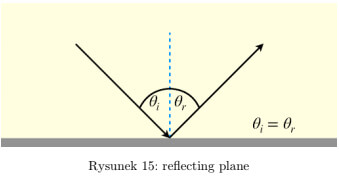
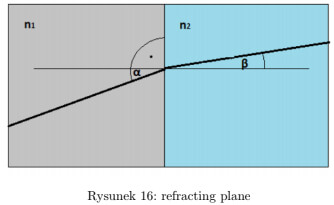 In optical systems, including lenses and telescopes, the optical axis refers to the imaginary line that passes through the centres of the curvatures of the lenses and mirrors. Focal points and focal lengths are located on the optical axis.
In optical systems, including lenses and telescopes, the optical axis refers to the imaginary line that passes through the centres of the curvatures of the lenses and mirrors. Focal points and focal lengths are located on the optical axis. -
Optical cavity / Optical resonator
Simple DifficultThe arrangement of mirrors or waveguides that allows a beam of light to travel in a closed path, most commonly utilized in lasers and cavity ring-down spectroscopy. -
Optical communication
Simple DifficultAny type of communication that uses light to transport information. Currently, the most popular form of optical communication is fiber optic communication. -
Optical fiber modes
Simple DifficultThe spatial distribution of an electromagnetic field in which light can propagate through the optical fiber. This distribution depends on the wavelength of the light, the material, the size of the optical fiber’s core, and the difference between the refractive indexes of the core and the optical fiber. -
Optical illusion
Simple DifficultA visual stimulus that is perceived by the brain in a different way than by the eyes. Optical illusions use a combination of colors, lights, and patterns to create images that mislead the brain. Optical illusions occur because the brain is designed to define reality based on simple, familiar shapes or objects. -
Optical spectroscopy
Simple DifficultA type of spectroscopy that is used to study optical spectra.
The optical spectra are analysed to obtain information about energy level structure (and any changes in it). To achieve this, the wavelength, intensity and line shape of the spectral lines are measured.A type of spectroscopy that is used to study optical spectra.
The optical spectra are analysed to obtain information about energy level structure (and any changes in it). To achieve this, the wavelength, intensity and line shape of the spectral lines are measured. -
Optical tomography
Simple DifficultTomographic measurement carried out with the use of electromagnetic radiation in the optical range, in which the image is created by reconstructing images produced by light transmitted, reflected and scattered through the body.
The requirement for the applicability of optical tomography is the light transmittance through the tested body, therefore it is used in medicine, during the examination of soft tissues.
Optical tomography is divided into several types:- Diffusion optical tomography
- Fluorescent molecular tomography
- Optical coherence tomography (OTC)
- Confocal diffusion tomography
-
Periscope
Simple DifficultAn optical instrument used to observe objects outside of one’s field of view. They are most commonly used in submarines - one is below the surface of the water but can observe events above the surface.
A periscope is built from a long tube with either mirrors orientated 45° with respect to each other at either end (right image), or prisms in line with each other (left image) along with a system of lenses.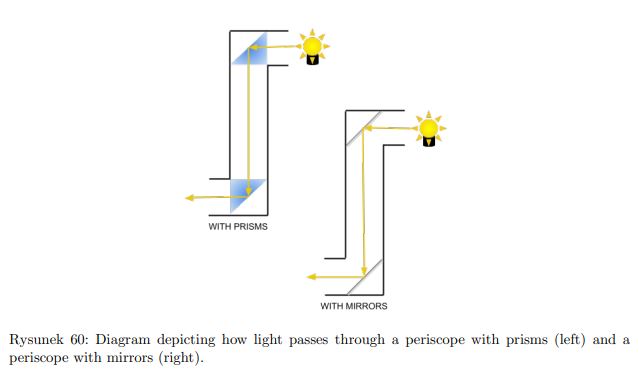
-
Phase
Simple DifficultThe phase of a wave summarises the state of a particular point on the wave with reference to its initial state; it tells us the location of the point on the wave at a given time within one period, T, of the wave (the time between the emergence of a point on one wave and the emergence of exactly the same point on the successive wave).
The phase is usually expressed in terms of an angle. For example, a phase of 0°/360° corresponds to when the point is in its initial position, while 180° corresponds to when the point is exactly halfway through one period of the wave.
-
Photonic crystal
Simple DifficultA type of nanostructure, where the refractive index changes periodically. It consists of unit cells with large and small refractive indexes that are arranged alternately, and are of the same order as the wavelength of light in a given spectral range.
Due to their structure, photonic crystals are divided into one, two and three-dimensional. -
Polarization
Simple DifficultA characteristic of a wave to oscillate in any direction. In optics it refers to the direction of the electric field oscillations in the electromagnetic field. -
Prism
Simple DifficultA solid usually made of glass which has at least two faces that slope towards each other that is used to refract light, for example separating white light into its constituent colours (see diagram). This is possible as different colours have different angles of refraction. A solid usually made of glass that has at least two faces that slope towards each other that is used to refract light, for example, separating white light into its constituent colours (see diagram).
A solid usually made of glass that has at least two faces that slope towards each other that is used to refract light, for example, separating white light into its constituent colours (see diagram).
-
Quantum efficiency
Simple DifficultDimensionless value indicating the ratio between number of charge carriers (electrons or holes) and the number of photons incident on a plane (for example on a semi-conductor). -
Quantum entanglement
Simple DifficultA physical phenomenon concerning an inseparability between two physical objects. Description of one of the objects is dependent on the other and vice versa. -
Quantum imaging
Simple DifficultA branch of quantum optics that enables new possibilities in terms of creating images. Examples of quantum imaging usages are quantum litography and sub-shot-noise imaging. -
Quantum key distribution (QKD)
Simple DifficultThe method of creating and broadcasting a secret quantum key in order to guarantee the security of communication between two parties. -
Quantum optics
Simple DifficultThe field of physics concerning the quantum mechanical description of interactions between light and matter. -
Quantum simulation
Simple DifficultA simulation produced by a quantum simulator, which is a device that permits the study of quantum systems that are difficult to study in the laboratory and impossible to model with a classical computer. -
Qubit
Simple DifficultThe basic unit of information in quantum computing. It is a superposition of two states. -
Qudit
Simple DifficultA unit of information in quantum computing, superposition of many states.
-
Real image
Simple DifficultThe image formed in the focal plane, resulting from the crossing of light rays passing through the optical system. In lenses, the image of the body is on the opposite side of the lens to the body, while for a mirror they are both on the same side.The image formed in the focal plane, resulting from the crossing of light rays passing through the optical system. In lenses, the image of the body is on the opposite side of the lens to the body, while for a mirror they are both on the same side. -
Refractive index
Simple DifficultA value summarising the extent of the refraction of light (or the change in direction of propagation of light) when it passes through the boundary between two media, for example from air to glass. It is denoted by the letter n.
When light passes from an optically less dense medium (such as air, n1 on the diagram) to an optically denser medium (such as water, n2 on the diagram) the angle of the light beam from the normal (the imaginary line perpendicular to the boundary) decreases. In this opposite situation (light passing from water to air) the angle increases.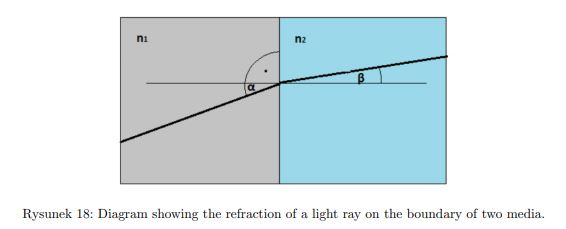
-
Retina
Simple DifficultPart of the eye onto which light rays converge after falling into our eye. This allows for an image of the object one is looking at to be formed. The retina has rods and cones, which detect light (low light and high light levels respectively). Cones also allow us to see colours - this is why when it gets dark, we cannot distinguish different colours as easily.
-
Scattering
Simple DifficultA physical phenomenon in which the direction of movement of light, waves, or particles changes due to interactions with the heterogeneous medium (its structure is not consistent) that they pass through. Light scattering occurs when light encounters a rough surface, causing the light to change direction without changing its frequency. -
Second harmonic generation
Simple DifficultA phenomenon occurring in experiments in nonlinear optics. It requires a wave of frequency ω to pass through a nonlinear medium. As a result, two waves leave the medium - one of frequency ω and the other with frequency of 2ω. -
Semiconductor
Simple DifficultA solid state with specific resistances that decrease with an increase in temperature (which is the opposite to regular conductors) and depends on external factors (such as temperature, light, impurities etc).
For a semiconductor to conduct electricity it must be provided with energy in the form of light or heat.
Semiconductors are commonly used in solar batteries that convert the energy in sunlight rays into electrical energy. -
SI prefixes
Simple DifficultA set of notations that represent particular powers of 10, which can be added before units. These notations are represented by particular letters (either Greek or Latin). They are listed in the table below.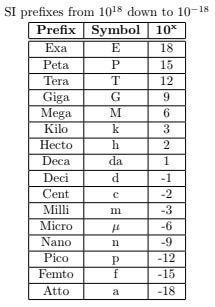 For example, the diameter of electrons are estimated to be less than 0,000000000000000001 m (so less than 1am), while the diameter of the sun is greater than 1000000000 m (so greater than 1 Gm).
For example, the diameter of electrons are estimated to be less than 0,000000000000000001 m (so less than 1am), while the diameter of the sun is greater than 1000000000 m (so greater than 1 Gm). -
Spectral filter
Simple DifficultA material that transmits only a small range of colors. -
Spectral lines
Simple DifficultA set of wavelengths emitted by every substance, atom or compound, as a result of radiation. -
Spontaneous emission
Simple DifficultThe phenomenon in which an electron’s energy is reduced (on the diagram, this corresponds to the transition between E2 to E1, E2 > E1) without any external factors inducing the process. This is accompanied by the emission of a photon with an energy equal to the difference between E2 and E1.
The phase and direction of the emitted photon is random.
Spontaneous emission is the phenomenon which governs the emission of light from light-emitting diodes (LEDs).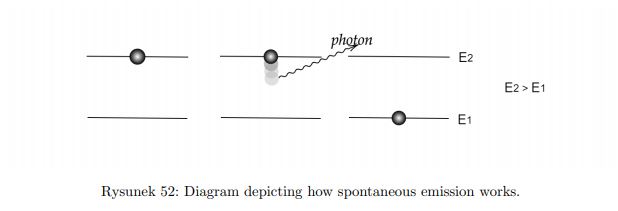
-
Stelar Michelson interferometer
Simple DifficultAn optical device used for measuring the diameter of individual stars. The stellar interferometer is one of the most famous kinds of Michelson interferometer and is widely used in optics and astronomy. -
Stimulated emission
Simple DifficultThe phenomenon in which an electron that has a higher energy than its original energy interacts with a photon, which can be thought of as an energy carrier. This interaction results in the lowering of the electron’s energy and the emission of another photon, which has an energy equal to the difference between the electron’s energy before and after interacting with the photon (on the diagram, this is the difference between E2 and E1). The photon emitted has the same frequency (and consequently energy), phase, direction of propagation (the direction in which it moves) and polarization (the direction of the photon’s oscillations) as the photon incident upon the electron. Lasers are based on the phenomenon of stimulated emission.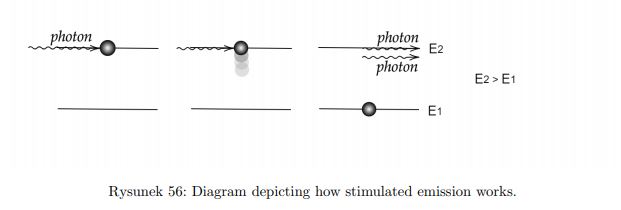
-
Telescope
Simple DifficultAn optical instrument used for the observation of far away objects, such as planets and stars. Telescopes can be used both from Earth or from Space. Telescopes can be constructed from lenses, mirrors or both lenses and mirrors. The diagram shows the structure of the simplest telescope: the Newtonian telescope. It is composed of two mirrors (Z1 and Z2), an eyepiece (Ok) and a tube (that houses the latter three components).
-
Thin lens
Simple DifficultA lens whose thickness is so small that it can be considered negligible (meaning that it can safely be ignored). For such lenses, the light passing through them refracts twice. -
Total internal reflection (TIR)
Simple DifficultTotal internal reflection is a special case of reflection; it occurs in the scenario where light passes from an optically denser medium (such as water, n1 on the diagram) into an optically less dense medium (such as air, n2 on the diagram). If the light falls from n2 into n1 then this phenomenon is not observed (one observes the phenomenon of refraction instead).
The angle of incidence of light must exceed the value of the critical angle, which is the angle at which the angle of refraction of the light is exactly 90°, for total internal reflection to occur. In TIR no light is transmitted into the second medium. Reflectors are an application of total internal reflection.
-
Transmission
Simple DifficultThe ratio of transmitted optical power to incident optical power. The transmission ratio can hold any value in the interval [0;1].qaz
-
Uncertainty limit
Simple DifficultA physical law, formulated by the German physicist Werner Heisenberg. It states that there are pairs of physical quantities that cannot be simultaneously measured with any accuracy. This is due to the very nature of the physical phenomena and not from the inaccuracy of the measurements.
-
Vignetting
Simple DifficultA defect of optical instruments resulting in the darkening of the edges of the obtained image.
This phenomenon is more prominent the greater the angle of incidence of light rays entering an optical device (e.g. a lens) is.
This effect decreases when the focal length is increased.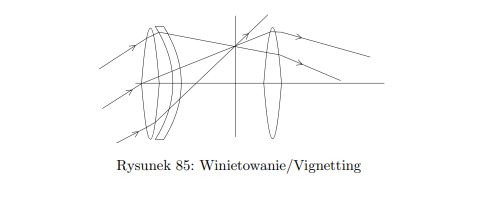 A defect of optical instruments resulting in the darkening of the edges of the obtained image.
A defect of optical instruments resulting in the darkening of the edges of the obtained image.
This phenomenon is more prominent the greater the angle of incidence of light rays entering an optical device (e.g. a lens) is.
This effect decreases when the focal length is increased.
-
Watt
Simple DifficultThe unit of power. it can be expressed in terms of SI base units as \( \frac{kg}{(m²·s³)} \), or in terms of the SI derived unit joule as \( \frac{J}{s} \). In other words, 1 Watt is the power obtained when 1 joule of work is done in 1 second. The Watt is usually just denoted by W.
A lightbulb of power of 80 W requires 8 times more energy in a given time than a lightbulb of power 10 W. -
Waveguide
Simple DifficultA structure that guides waves in a specified direction or plane. -
Wavelength
Simple DifficultThe distance (λ) between two points in space, oscillating in the same phase. This distance is most commonly measured between two neighbouring peaks or two neighbouring troughs (the two positions on the wave with maximum amplitude).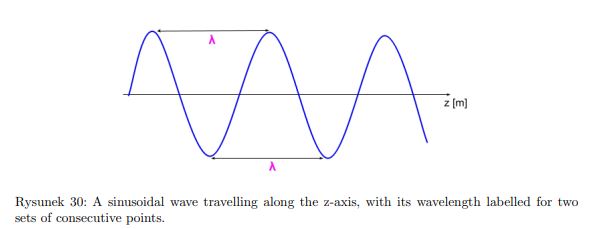
-
Wavenumber
Simple DifficultA parameter that describes the propagation of a wave in the space, similarly to how the frequency of a wave describes the changes of the state of a wave in time.